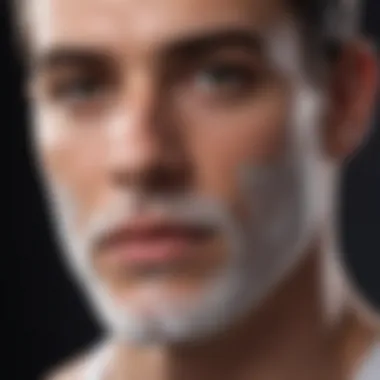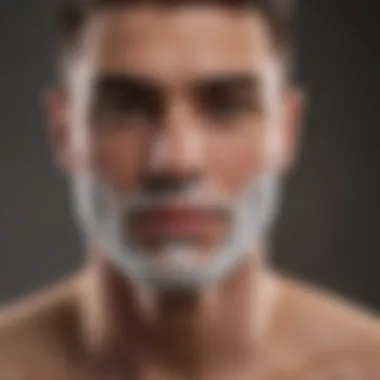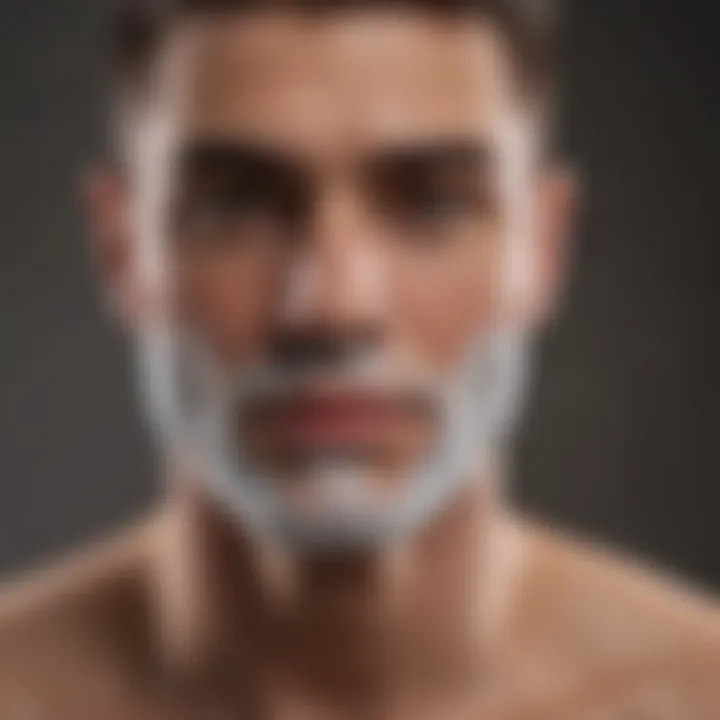Understanding Razor Bumps: Causes and Solutions


Intro
Razor bumps are a skin irritation that occur frequently after shaving. This condition impacts many people, regardless of their shaving techniques or the products used. Understanding the causes of razor bumps is essential to mitigate their occurrence and improve the overall shaving experience.
This article will delve into the underlying reasons that lead to the formation of razor bumps, including skin sensitivity, improper shaving methods, and hair type characteristics. It will also provide preventative measures, demonstrate proper shaving techniques, and recommend aftercare routines designed to alleviate this common issue. The insights presented aim to furnish readers with a comprehensive understanding of razor bumps. This knowledge will assist in achieving a smoother and irritation-free shave, which can significantly enhance one’s grooming routine.
Foreword to Razor Bumps
Razor bumps, often a nuisance for many, have considerable implications on skin health and personal grooming. Understanding this condition is essential because it goes beyond mere aesthetics. When individuals experience razor bumps, they may encounter discomfort, irritation, and even lasting effects on the skin's appearance. Addressing these issues becomes critical, especially for men who prioritize fashion and shaving as part of their grooming routines.
This article provides a comprehensive guide to understanding razor bumps, exploring their causes, and identifying effective solutions. Recognizing the relevance of frequently experiencing razor bumps can influence one's choices in shaving methods and skincare products. Improved knowledge leads to informed decisions that promote skin health and enhance one’s grooming experience.
Moreover, by understanding how razor bumps occur, readers can take proactive steps to mitigate their occurrence. This overall understanding not only promotes better personal care but also boosts confidence in one’s appearance.
Understanding the Skin
Understanding the skin is essential in addressing the issue of razor bumps. Every individual has different skin characteristics that influence how their skin reacts to shaving. Recognizing these differences can help find tailored solutions to minimize irritations like razor bumps.
The skin is made up of various layers, each serving specific functions. The outermost layer, known as the epidermis, acts as a protective barrier. Below this are the dermis and subcutaneous layers, which house the hair follicles, nerves, and blood vessels. Consequently, a good grasp of skin anatomy allows one to comprehend how shaving impacts these layers directly. Knowing the skin type—be it oily, dry, or sensitive—can inform better choices for shaving products and techniques, significantly reducing the risk of irritation.
Skin Types and Sensitivities
Skin types play a pivotal role in how razor bumps develop post-shave. There are four primary skin types: normal, oily, dry, and combination. Each skin type has unique sensitivities that can affect the shaving experience.
- Normal skin is usually resilient and responds well to most shaving products. However, it can still suffer from razor bumps in certain conditions.
- Oily skin tends to produce excess sebum, leading to clogged pores. This can exacerbate irritation from shaving, thus increasing the likelihood of razor bumps.
- Dry skin lacks moisture and can become inflamed due to friction during shaving. It is imperative to select hydrating products to avoid worsening this condition.
- Combination skin can vary across the face, so understanding which areas are more sensitive is crucial for effective care.
Identifying one's skin sensitivity is also vital. Some individuals may react negatively to certain ingredients in shaving gels, creams, or aftercare products. Fragrance, alcohol, and harsh chemicals can trigger reactions in sensitive skin, leading to irritated follicles. Thus, always checking ingredient labels is recommended to avoid harshness.
The Role of Hair Follicles
Hair follicles are integral to understanding razor bumps. They are tiny structures in the skin from which hair grows. When hair is removed through shaving, it may sometimes grow back into the skin instead of outwards, particularly in curly or coarse hair textures. This phenomenon, known as ingrown hairs, leads to inflammation, redness, and, ultimately, razor bumps.
The shape of hair follicles can influence the direction in which hair grows. Curly hair, for example, has a higher chance of becoming ingrown compared to straight hair. The tight curl can make it difficult for hair to break through the skin’s surface, resulting in bumps and irritation.
Maintaining healthy hair follicles involves ensuring they are unclogged and well-nourished. Regular exfoliation helps remove dead skin cells, preventing hair from getting trapped under the surface. Additionally, using a moisturizing shave gel can create a protective barrier, making it easier for hair to grow naturally out of the follicle.
Common Causes of Razor Bumps
Understanding the common causes of razor bumps is crucial for both prevention and treatment. This condition often leads to discomfort and can impact overall grooming practices. The reasons vary but typically stem from individual factors such as skin type, hair texture, and shaving techniques. Identifying these causes allows for more tailored solutions, which can ultimately enhance the shaving experience and promote healthier skin. By grasping why razor bumps occur, men who are into fashion and style can make informed choices that minimize irritation and maintain a polished appearance.
Ingrown Hairs Explained
Ingrown hairs are one of the leading causes of razor bumps. They occur when hair grows back into the skin instead of rising out of the follicle. This can happen especially when the hair is coarse or curly, making it more prone to curling back into the skin after being cut. The result is a raised bump that can be irritating and sometimes painful.
To prevent ingrown hairs, it is essential to understand how they form:
- Shaving Direction: Shaving against the grain can cut the hair too short, causing it to curve back and embed into the skin.
- Hair Type: Curly hair is more likely to become ingrown due to its shape.
- Skin Care Routine: Failing to exfoliate can lead to dead skin cells trapping hair inside the follicle.
Adopting proper shaving techniques can significantly reduce the likelihood of ingrown hairs.
Sensitivity to Products


Another common cause of razor bumps is sensitivity to certain shaving products. Many chemical ingredients in gels, creams, or lotions can irritate the skin, leading to inflammation and discomfort after shaving. For men who are into fashion and style, using the wrong products can affect both the appearance of the skin and comfort.
Factors contributing to sensitivity include:
- Fragrance: Many products contain strong fragrances that may irritate sensitive skin.
- Alcohol Content: Some aftershaves or pre-shave treatments have high alcohol levels, leading to dryness and irritation.
- Synthetic Ingredients: Preservatives and harsh chemicals can cause allergic reactions, manifesting as razor bumps.
To mitigate these effects, it is advisable to choose hypoallergenic and natural products, ensuring better compatibility with skin types.
Improper Shaving Techniques
Improper shaving techniques are at the forefront of causing razor bumps. Many individuals may not realize the impact of their method on skin health. Key elements of improper techniques include:
- Using Dull Blades: A dull razor requires more pressure to cut through hair, resulting in uneven cuts and increased irritation.
- Skipping Preparation: Not preparing the skin adequately can lead to increased friction and irritation.
- Over-Shaving: Going over the same area multiple times creates unnecessary trauma to the skin.
These methods not only contribute to razor bumps but also leave the skin looking rough and uneven.
By improving techniques and being mindful of skin health, individuals can significantly reduce the incidence of these bumps, achieving that desired smooth look.
Shaving Techniques to Minimize Razor Bumps
Shaving can be a routine task, but it requires careful attention to minimize skin irritation, specifically razor bumps. Razor bumps happen when hairs grow back into the skin after shaving, leading to inflammation and discomfort. Hence, employing appropriate shaving techniques becomes essential. Effective methods can greatly reduce the risk of irritation, leading to a smoother shave and healthier skin. Knowing the correct techniques also improves one's overall grooming experience.
Preparing the Skin for Shaving
Preparation of the skin is an integral step. It will affect the entire shaving process. Start with a warm shower or apply a warm towel to your face. This helps open up the pores and soften the hair follicles, making them easier to cut. After this, gently exfoliate the skin using a mild scrub or a washcloth. This removes dead skin cells and helps prevent ingrown hairs. Using a pre-shave oil can also be beneficial. Oil provides an additional layer of protection, allowing the razor to glide more smoothly over the skin.
- Warm up your skin
- Exfoliate gently
- Apply pre-shave oil
Following these steps can significantly reduce the occurrence of razor bumps.
Choosing the Right Razor
Selecting the right razor plays a pivotal role in minimizing razor bumps. Not all razors work the same for every individual. Many find that safety razors or cartridge razors with multiple blades may provide a closer shave and reduce irritation. Electric razors, on the other hand, can be suitable for sensitive skin, as they typically do not cut as closely. It's essential to choose a razor suited to your skin type and hair texture. Also, ensure that the blades are sharp and clean. Dull blades can drag across the skin, causing irritation and leading to razor bumps.
"The right razor can be a game-changer in your shaving routine."
Direction of Shaving
The direction in which one shaves is crucial for reducing the risk of razor bumps. Shaving with the grain, meaning in the direction of hair growth, is often recommended. This approach decreases the likelihood of hair being cut too short or becoming trapped beneath the skin. For some, it may be beneficial to shave across the grain for a closer finish, but this should be approached with caution. After completing the initial pass, one can assess the skin's reaction before considering any additional strokes.
- Shave with the grain
- Assess skin reaction after initial pass
- Be cautious with cuts against the grain
Following correct shaving techniques is both an art and a science that requires practice and understanding. The right approach can pave the way to a more comfortable shaving experience while significantly reducing the occurrence of razor bumps.
Aftercare for Razor Bumps
After receiving a fresh shave, one might feel a sense of accomplishment, but this is often followed by the unwelcome appearance of razor bumps. Effective aftercare plays a critical role in minimizing irritation and promoting skin recovery. Post-shave practices are not mere suggestions; they can significantly reduce discomfort and improve overall skin health. Understanding the components of aftercare helps individuals choose the right path to a smoother experience.
Soothing Products
Choosing the right soothing products after shaving is essential. Various formulations exist, tailored to calm the skin, reduce redness, and prevent bumps. Products containing aloe vera, witch hazel, or tea tree oil are notable examples. These natural ingredients serve as anti-inflammatory agents, which can alleviate discomfort. Specifically, aloe vera gel offers hydration and cooling effects, while witch hazel can tighten skin and reduce swelling.


- Aloe Vera Gel: Known for its soothing properties.
- Witch Hazel: Acts as an astringent; can help with swelling and irritation.
- Tea Tree Oil: Possesses antimicrobial properties.
Using these products consistently can create a protective barrier against irritation. Furthermore, opting for alcohol-free aftershaves is advisable. Alcohol can dry the skin, leading to excessive irritation. Instead, choose soothing balms specifically designed for immediate post-shave care.
Moisturizing Techniques
Moisturizing is a crucial step that often gets overlooked. Post-shave skin requires nourishment to maintain suppleness. Apply a lightweight moisturizer that does not clog pores. Ingredients like hyaluronic acid or glycerin help retain moisture.
To enhance the effectiveness of these products, consider the following techniques:
- Gentle Application: Use a patting motion to apply moisturizer. Rubbing may irritate the skin further.
- Timing: Apply immediately after shaving. This helps lock in moisture while the skin is still slightly damp.
- Regular Use: Form a habit to moisturize daily, not just after shaving. This leads to long-term skin health.
Avoiding Irritation Post-Shave
Preventing irritation after shaving is as crucial as selecting the right blade or technique. Keeping irritation at bay can be achieved through several practical steps.
To avoid additional irritation:
- Avoid Hot Showers: Immediately after shaving, skip hot water on the skin. Warm water is fine but hot water can worsen irritation.
- Wear Loose Clothing: Tight clothes can rub against freshly shaved skin. This can lead to friction and further bumps. Opt for breathable fabrics.
- Limit Scrubbing or Exfoliating: In the hours following shaving, refrain from exfoliating the area. This allows the skin to heal without additional stress.
Taking care of your skin post-shave is as important as the shave itself. Proper aftercare can set the foundation for a more comfortable experience and a healthier complexion.
Exploring Alternatives to Traditional Shaving
Exploring alternatives to traditional shaving is important for those seeking to reduce the discomfort associated with razor bumps. Many men find that the conventional methods lead to skin irritation, requiring exploration of other options. This section focuses on different methods of hair removal that can potentially minimize the occurrence of razor bumps and provide smoother skin.
Electric Razors vs. Manual Razors
When considering electric razors and manual razors, it's essential to understand how each method impacts skin health. Electric razors are designed to cut hair without direct contact with the skin. This minimizes irritation and the risk of ingrown hairs. However, some electric razors may not achieve the close shave that many prefer, which might lead individuals to choose manual razors, which can give a closer, cleaner look.
Key Differences:
- Irritation: Electric razors tend to cause less irritation
- Technique: Manual razors require more technique and care
- Shaving Time: Electric razors can often lead to quicker shaves
Consider testing both types and observing how your skin reacts. This self-assessment is key in finding the best option for you.
Hair Removal Creams: Pros and Cons
Hair removal creams are an alternative to shaving that can be appealing. They work by breaking down the protein structure of hair, allowing it to be wiped away easily.
Pros:
- Pain-Free: Generally less painful compared to traditional shaving
- Speed: Quick application can save time
- Results: Offers a smooth finish
Cons:
- Skin Sensitivity: Some may experience rashes or burning
- Odor: Certain creams have a strong chemical smell
- Shorter-Lasting Results: Hair grows back quicker than with shaving
Before using hair removal creams, perform a patch test to check for allergic reactions. This helps ensure a safer hair removal experience.
Laser Hair Removal Options


Laser hair removal presents a more permanent solution to hair removal and the issues that come with traditional shaving. This method uses concentrated light to target and destroy hair follicles, leading to long-term reduction in hair growth. While effective, laser hair removal typically requires multiple sessions to achieve desired results.
Considerations:
- Cost: Generally more expensive than traditional shaving methods
- Time Commitment: Multiple sessions needed for effectiveness
- Dermatologist Consultation: A professional evaluation is essential to determine suitability
Ultimately, exploring these alternatives could lead to a significant reduction in razor bumps and improved skin health. Each option comes with its own set of benefits and drawbacks, making it necessary to consider what aligns best with your personal grooming preferences.
Myths and Misconceptions about Razor Bumps
Razor bumps are often surrounded by a variety of myths and misconceptions that can mislead many individuals seeking solutions. Understanding these false beliefs is essential for accurately addressing the problem. Many people may believe that razor bumps are simply a result of poor shaving habits, while in reality, they can be influenced by numerous factors such as skin type, genetics, and even emotional responses to skin irritation. By debunking these myths, readers can gain a clearer understanding of how to prevent and treat razor bumps effectively, ultimately leading to a smoother shaving experience.
Common Myths Debunked
- Myth: Razor bumps only affect those with curly hair.
Fact: While individuals with curly hair are more prone to ingrown hairs, anyone can experience razor bumps regardless of their hair type. Factors such as skin sensitivity and shaving technique play significant roles. - Myth: Using a dull razor will not cause issues if used lightly.
Fact: A dull razor can actually increase the likelihood of irritation and razor bumps, as it requires more pressure to shave, often leading to uneven cuts and increased friction against the skin. - Myth: You can shave over bumps to make them disappear.
Fact: Shaving over existing bumps can exacerbate the problem, causing further irritation and possibly introducing bacteria into the hair follicle. It is advisable to wait until the bumps have healed. - Myth: All aftershave products cause razor bumps.
Fact: While some aftershave products can irritate sensitive skin, there are many that are specifically formulated to soothe and heal post-shave irritation. Choosing the right product is key. - Myth: Razor bumps will go away on their own without any intervention.
Fact: Though some bumps may resolve independently, many require proactive treatment to prevent further irritation and to heal effectively.
Understanding the reality behind these myths can guide individuals towards more effective practices, avoiding common pitfalls.
Cultural Perspectives and Their Influence
Culture can shape perceptions and attitudes towards razor bumps significantly. Different communities approach grooming and skincare with diverse practices and beliefs. In some cultures, there is a strong emphasis on smooth skin as a standard of beauty, which can lead to stigmatization of those who experience razor bumps. This social pressure may drive individuals toward aggressive shaving methods that sometimes worsen the condition.
In other cultures, the concept of masculinity is closely tied to grooming habits. Men may avoid showing vulnerability regarding skin issues, including razor bumps, leading to secrecy around their skincare routines. This can further perpetuate misinformation as men might avoid discussing their experiences, thus missing out on valuable advice.
Beyond the personal aspect, understanding cultural perspectives can inform product development in the shaving industry, as brands target specific demographics. They might emphasize certain ingredients or techniques that resonate more with particular cultural values. Knowing how culture influences skincare can help individuals make informed choices, thus enhancing their shaving experience and minimizing the occurrence of razor bumps.
Long-Term Solutions and Skin Health
Long-term solutions to managing razor bumps are essential for individuals who desire not only to alleviate their immediate discomfort but also to ensure the health of their skin over time. Understanding the root causes of razor bumps and adopting preventive measures can minimize their occurrence, leading to greater skin comfort and confidence. It is crucial to embrace practices that not only address existing issues but also promote overall skin health. This entails a commitment to consistent skincare routines and choosing the right professional advice.
Consulting a Dermatologist
Consulting a dermatologist can be a significant step in addressing persistent razor bumps. Dermatologists are specialists in skin health and can provide tailored advice based on individual skin types and conditions. During a consultation, a dermatologist may:
- Evaluate Skin Type: Identifying specific skin types can lead to personalized recommendations.
- Diagnose Underlying Issues: Skin conditions such as folliculitis might be confused with razor bumps, hence proper diagnosis is important.
- Prescribe Treatments: Certain skincare products or medications may be recommended to alleviate inflammation and prevent further irritation.
Many individuals may hesitate to seek professional advice, thinking they can manage the issue personally. However, once razor bumps become recurrent, timely intervention can save much discomfort in the future.
Maintaining Overall Skin Health
Maintaining overall skin health is equally necessary in the quest for smoother shaving experiences. A consistent skincare regimen can strengthen skin resilience and prevent the formation of razor bumps. Key components of this maintenance include:
- Daily Cleansing: Regularly cleansing the skin keeps pores clear of dirt and reduces the risk of ingrown hairs.
- Exfoliation: Gentle exfoliation a few times a week can help remove dead skin cells, preventing hair from becoming trapped beneath the skin's surface.
- Hydration: Moisturizing regularly keeps the skin supple, reducing irritation during shaving.
- Sun Protection: Using sunscreen protects against UV damage and helps maintain skin health.
Finale
In the discussion of razor bumps, it is crucial to recognize the multifaceted nature of this common issue. Razor bumps are not simply a result of poor shaving practices; they reflect a complex interplay of skin type, hair characteristics, and environmental influences. Understanding these elements can lead to better management strategies and a more successful shaving experience.
Summary of Key Points
Several key points emerged throughout the article:
- Razor bumps stem primarily from ingrown hairs, which can occur due to improper shaving techniques or sensitivity to products.
- Preparing the skin thoroughly and using the correct tools, such as the right razor or shaving cream, can significantly reduce the likelihood of developing bumps.
- Aftercare is just as important as the shaving process itself. Using soothing products and effective moisturizing techniques can help alleviate discomfort.
- Exploring alternatives like electric razors and laser hair removal can offer long-term solutions.
- Finally, consulting with a dermatologist is advisable for persistent issues, as professional guidance can lead to tailored solutions based on individual skin and hair types.
Final Thoughts on Managing Razor Bumps
Managing razor bumps requires a strategic approach. It is important to remain aware of the products and techniques used during shaving. Regularly reassessing one's shaving routine might reveal areas needing improvement. Individuals are encouraged to prioritize skin health alongside appearance. A well-maintained shaving regime can enhance not just skin health but also overall confidence.
To truly minimize discomfort, one must embrace a holistic view, considering all contributing factors—everything from product ingredients to shaving direction can play a pivotal role. In doing so, men invested in fashion and style can enjoy a smoother and more flawless appearance without the unnecessary interruptions caused by razor bumps.















